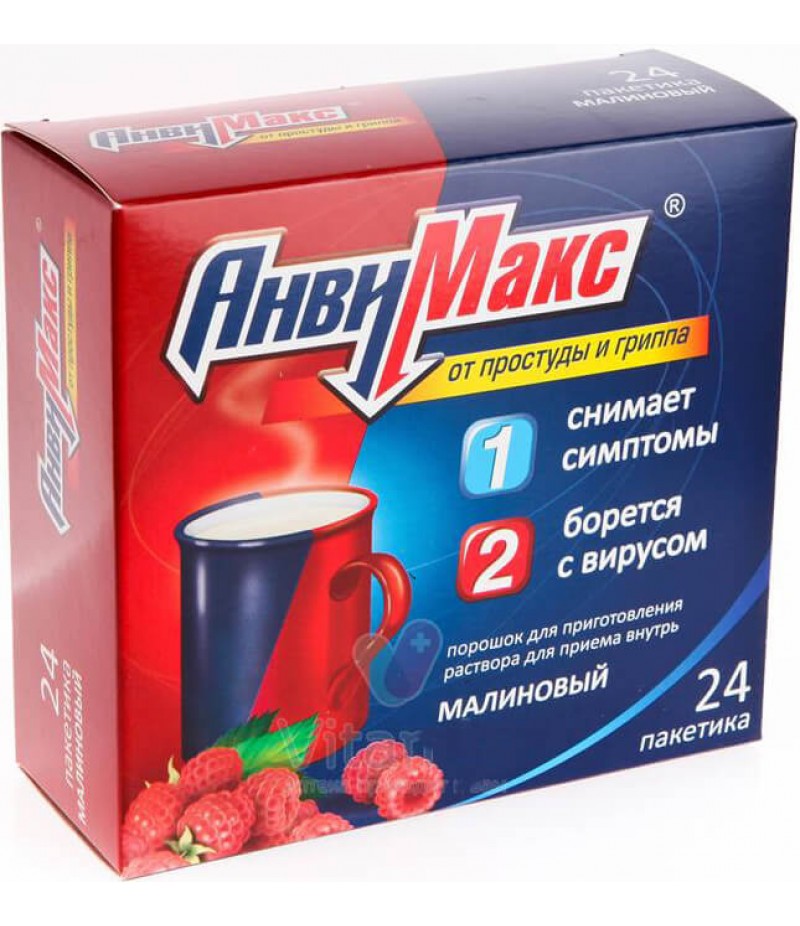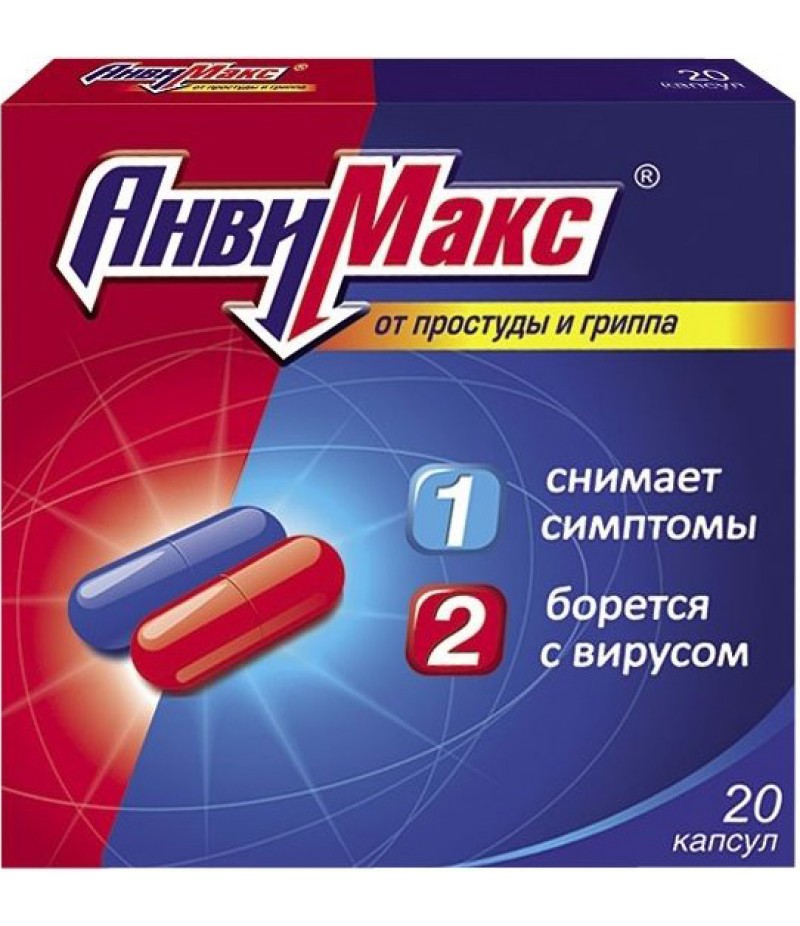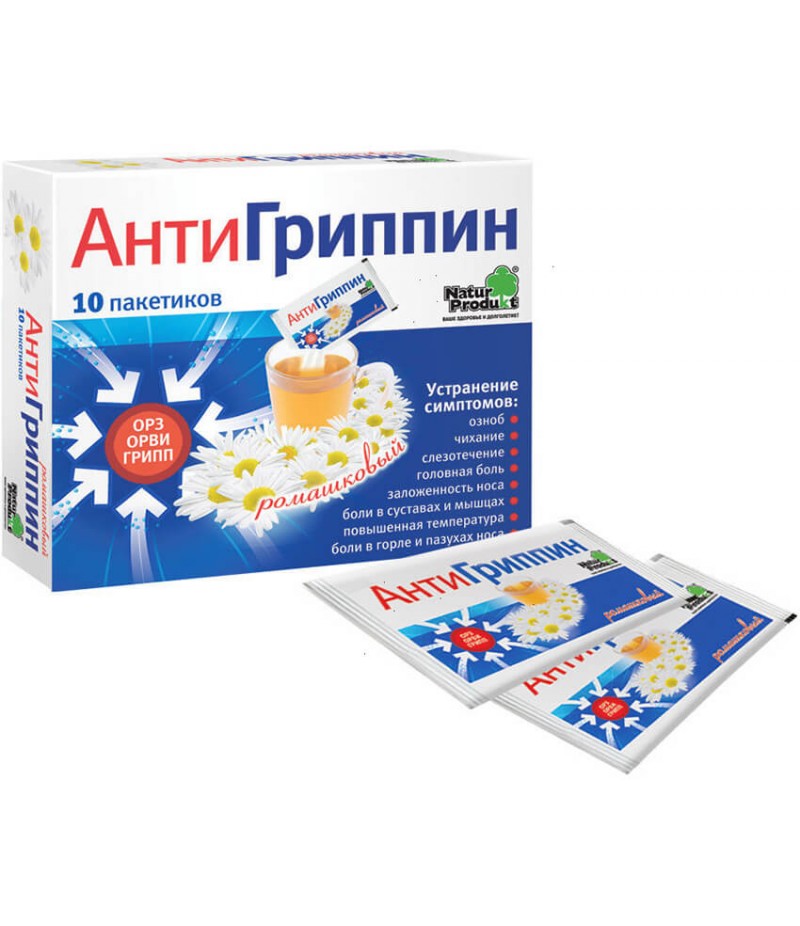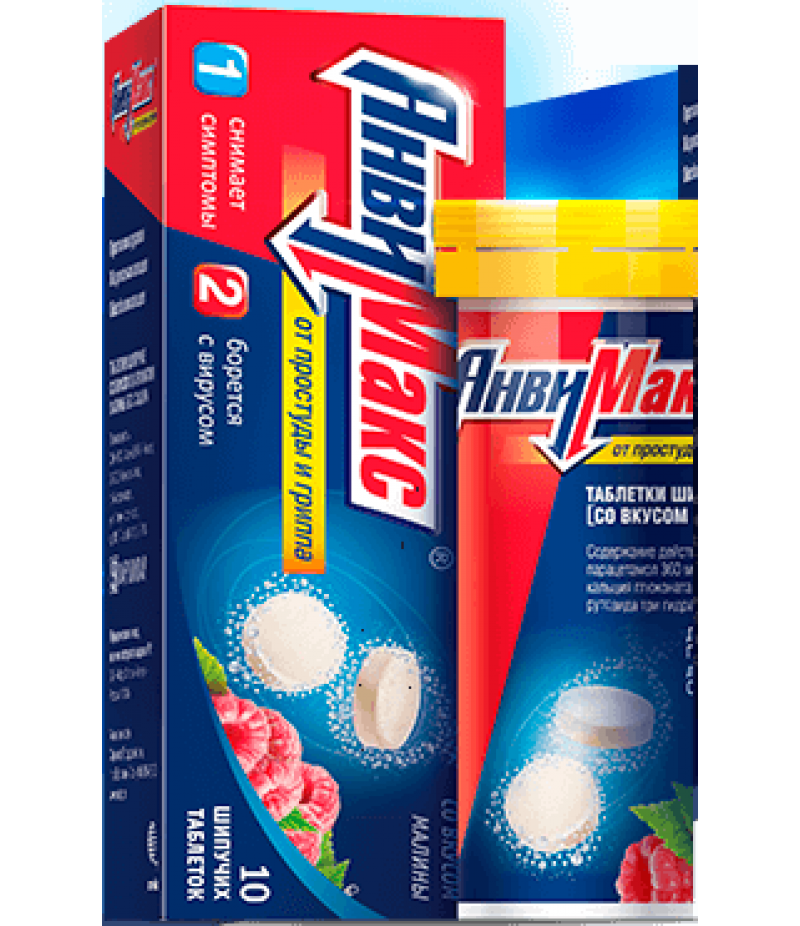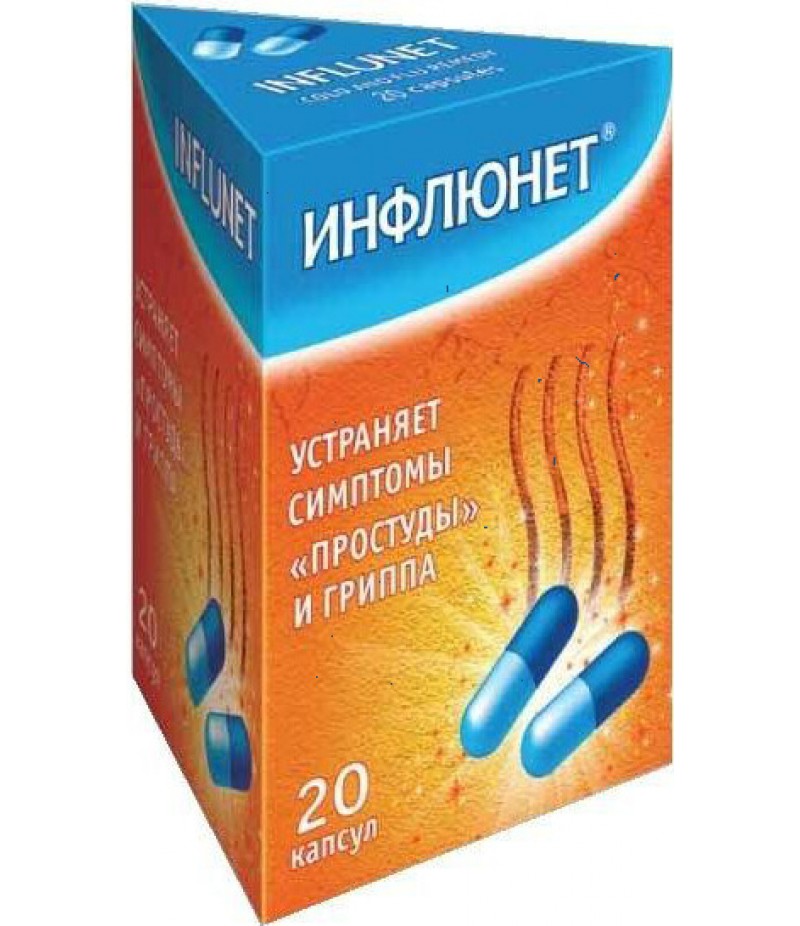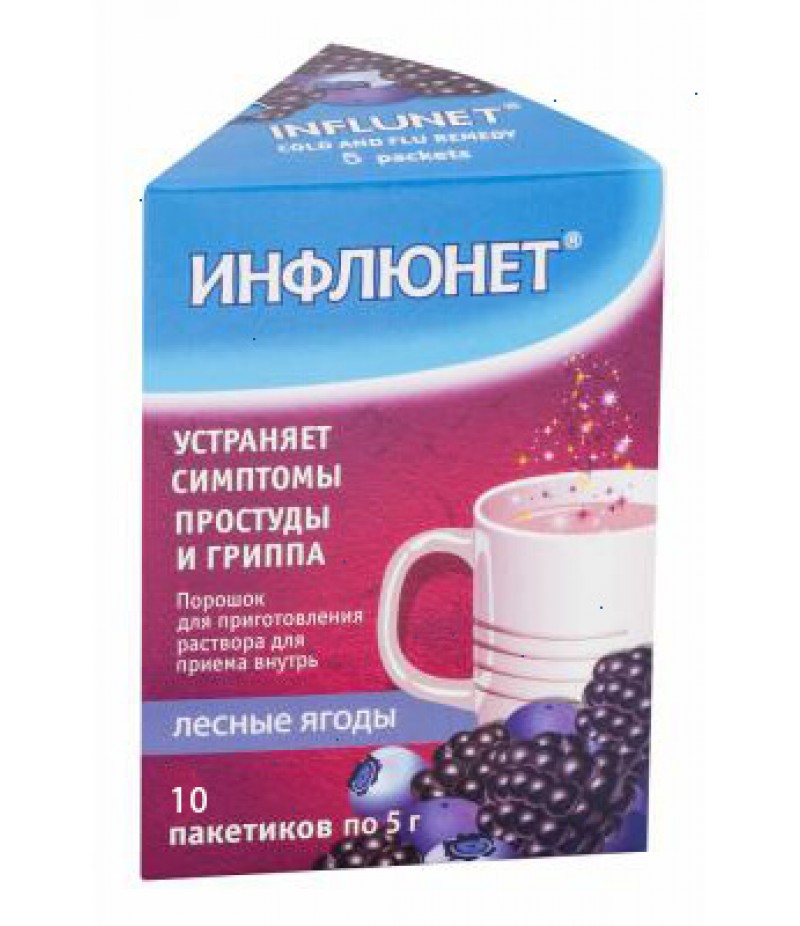AnviMax powder #24
- $28.20
- 3 or more $27.98
- Availability:In Stock
AnviMax powder instruction for useReed more and buy AnviMax powder on this pageActive substances- ascorbic acid (ascorbic acid)- calcium gluconate (calcium gluconate)- loratadineparacetamol- rimantadine hydrochloride (rimantadine)..
Tags: powder
AnviMax powder instruction for use
Reed more and buy AnviMax powder on this page
Active substances
- ascorbic acid (ascorbic acid)
- calcium gluconate (calcium gluconate)
- loratadine
paracetamol
- rimantadine hydrochloride (rimantadine)
- rutoside (in the form of trihydrate) (rutoside)
Form of release, composition and packaging
Capsules of two kinds.
Capsules P hard gelatinous, size №0, blue; contents of capsules - a mixture of powder and granules white or white with a cream or pinkish hue, it is allowed to have lumps (10 pieces per pack).
1 caps.
paracetamol 360 mg
Excipients: pregelatinized starch - 9 mg, colloidal silicon dioxide - 3 mg, lactose monohydrate - 1.2 mg, magnesium stearate - 3.8 mg, polysorbate 80 - 3 mg.
The composition of the hard gelatin capsule: gelatin - 94.795 mg, blue patented (E131) or brilliant blue (E133) - 0.265 mg, titanium dioxide (E171) - 1.94 mg.
Capsules P hard gelatinous, size No. 0, red; the contents of the capsules - a mixture of powder and granules from yellow to yellow with a greenish tinge and white, lumps (10 pieces per package) are allowed.
1 caps.
ascorbic acid 300 mg
calcium gluconate monohydrate 100 mg
rimantadine hydrochloride 50 mg
rutoside (in the form of trihydrate) 20 mg
loratadine 3 mg
Auxiliary substances: potato starch - 2.2 mg, magnesium stearate - 4.8 mg.
The composition of the hard gelatin capsule: gelatin - 94.064 mg, iron dye oxide yellow (E172) - 0.97 mg, iron dye red oxide (E172) - 0.485 mg, pencil dye [Ponso 4R] (E124) - 0.511 mg, titanium dioxide (E171) - 0.97 mg.
20 pcs. (10 caps of blue and 10 capsules of red) - packings of cellular contour (2) - packs of cardboard.
Powder for the preparation of a solution for ingestion [cranberry, lemon, lemon with honey, raspberry, black currant] in the form of a mixture of powder and granules from almost white to yellow with a greenish tint of color, with a characteristic smell (cranberries or lemon, or lemon with honey, or raspberry, or black currant); allowed the presence of single granules of pink color; the prepared solution is colorless or with a yellowish tinge, slightly cloudy, with a characteristic odor (cranberry or lemon, or lemon with honey, or raspberry, or black currant); the presence of undissolved yellow particles is allowed.
1 pack.
paracetamol 360 mg
ascorbic acid 300 mg
calcium gluconate monohydrate 100 mg
rimantadine hydrochloride 50 mg
rutoside (in the form of trihydrate) 20 mg
loratadine 3 mg
Auxiliary substances: aspartame - 30 mg, hypromellose - 10 mg, silicon dioxide colloid - 20 mg, lactose monohydrate - 4086 mg, flavor (cranberry or lemon, or lemon and honey, or crimson or blackcurrant) - 21 mg.
5 g - bags of heat-sealing (3) - packs cardboard.
5 g - bags of heat-sealing (6) - packs cardboard.
5 g - bags of heat-sealing (12) - packs cardboard.
5 g - bags of heat-sealing (24) - packs cardboard.
pharmachologic effect of Anvimax powder
The combined preparation possesses antiviral, interferonogenic, antipyretic, analgesic, antihistaminic and angioprotective action.
Paracetamol has an analgesic and antipyretic effect.
Ascorbic acid is involved in the regulation of oxidation-reduction processes, promotes normal capillary permeability, blood coagulability, tissue regeneration, plays a positive role in the development of immune responses of the body, replenishes vitamin C deficiency.
Calcium gluconate, as a source of calcium ions, prevents the development of increased permeability and fragility of the vessels that cause hemorrhagic processes in influenza and SARS, has an antiallergic effect (the mechanism is unclear).
Rimantadine has antiviral activity against influenza A virus. By blocking the M2 channels of the influenza A virus, it breaks its ability to penetrate cells and release the ribonucleoprotein, thereby inhibiting the most important stage of viral replication. It induces the production of interferons alpha and gamma. With influenza caused by virus B, rimantadine exerts an antitoxic effect.
Rutoside is an angioprotector. Reduces the permeability of capillaries, swelling and inflammation, strengthens the vascular wall. It inhibits aggregation and increases the degree of erythrocyte deformation.
Loratadine - a blocker of histamine H1 receptors, prevents the development of edema of the tissues associated with the release of histamine.
Pharmacokinetics of Anvimax powder
Paracetamol
Suction and distribution
Absorption is high. Based on the results of clinical studies, the following pharmacokinetic parameters of paracetamol were established: when using capsules of Cmax paracetamol in blood plasma is achieved through 1.20 ± 0.72 hours and is 5.01 ± 1.70 μg / ml, with the use of powder - after 0.7 ± 0.39 hours and is 4.79 ± 1.81 μg / ml.
Binding to plasma proteins - 15%. Penetrates through the BBB.
Metabolism and excretion
Metabolised in the liver in three main ways: conjugation with glucuronides, conjugation with sulfates, oxidation with microsomal enzymes of the liver. In the latter case, toxic intermediate metabolites are formed, which are subsequently conjugated to glutathione, and then to cysteine and mercapturic acid. The main isoenzymes of cytochrome P450 for this pathway of metabolism are the isoenzyme CYP2E1 (predominantly), CYP1A2 and CYP3A4 (a secondary role). With a deficiency of glutathione, these metabolites can cause damage and necrosis of hepatocytes. Additional metabolic pathways include hydroxylation to 3-hydroxyparacetamol and methoxylation to 3-methoxyparacetamol, which are subsequently conjugated to glucuronides or sulfates. In adults, glucuronation predominates. Conjugated metabolites of paracetamol (glucuronides, sulfates and conjugates with glutathione) have low pharmacological (including toxic) activity.
It is excreted by the kidneys in the form of metabolites, mainly conjugates, only 3% unchanged. According to the results of clinical trials, T1 / 2 paracetamol is 3.04 ± 1.01 hours when Anvimax powder is taken in capsules, 2.73 ± 0.76 h - when taking the drug in the form of a powder.
Pharmacokinetics in special clinical cases
In elderly patients, the clearance of Anvimax powder decreases and T1 / 2 increases.
Ascorbic acid
Suction and distribution
Absorbed from the gastrointestinal tract (mainly in the jejunum). Diseases of the gastrointestinal tract (peptic ulcer of stomach and duodenum, constipation or diarrhea, helminthic invasion, giardiasis), the use of fresh fruit and vegetable juices, alkaline drink reduce the absorption of ascorbic acid in the intestine. The concentration of ascorbic acid in the plasma is normally around 10-20 μg / ml. Time to reach Cmax in the blood plasma after ingestion - 4 hours.
Binding to plasma proteins - 25%. Easily penetrates into leukocytes, platelets, and then into all tissues; the greatest concentration is achieved in glandular organs, leukocytes, liver and lens of the eye; penetrates the placental barrier. The concentration of ascorbic acid in leukocytes and platelets is higher than in erythrocytes and in plasma. With deficient states, the concentration in leukocytes decreases later and more slowly and is considered as the best criterion for assessing the deficit than the concentration in the plasma.
Metabolism and excretion
Metabolised mainly in the liver in desoxyascorbic and then in oxaloacetic acid and ascorbate-2-sulfate.
It is excreted by the kidneys, through the intestine, with sweat in unchanged form and in the form of metabolites.
Pharmacokinetics in special clinical cases
Smoking and the use of ethanol accelerate the destruction of ascorbic acid (conversion into inactive metabolites), sharply reducing the reserves in the body.
It is in hemodialysis.
Calcium gluconate
Approximately 1 / 5-1 / 3 part of the orally administered calcium gluconate is absorbed into the small intestine; this process depends on the presence of ergocalciferol, pH, dietary characteristics and the presence of factors capable of binding calcium ions. The absorption of calcium ions increases with its deficiency and the use of a diet with a reduced content of calcium ions.
About 20% is excreted by the kidneys, the rest (80%) is the intestine.
Rimantadine
Suction and distribution
After oral administration, it is almost completely absorbed in the intestine. Absorption is slow. According to the results of clinical studies, the following pharmacokinetic parameters of rimantadine are established: when using capsules Cmax in blood plasma is achieved through 4.53 ± 2.52 hours and is 68.2 ± 26.6 ng / ml, when the drug is administered in the form of a powder - after 5.28 ± 2.54 h and is 69 ± 19.7 ng / ml.
Binding to plasma proteins is about 40%. Vd - 17-25 l / kg. Concentration in the discharge from the nose is 50% higher than in plasma.
Metabolism and excretion
Metabolised in the liver. More than 90% is excreted by the kidneys within 72 hours, mainly in the form of metabolites, 15% - in unchanged form. According to the results of clinical trials, T1 / 2 rimantadine is 30.51 ± 9.83 h when the preparation is administered in the form of capsules, 33.26 ± 12.76 h - when Anvimax powder is administered in the form of a powder.
Pharmacokinetics in special clinical cases
In chronic renal failure, T1 / 2 increases by 2 times. In persons with renal insufficiency and in elderly people, rimantadine may accumulate in toxic concentrations if the dose is not adjusted proportionally to a decrease in QC. Hemodialysis has an insignificant effect on the clearance of rimantadine.
Rutozid
The time to reach Cmax in the blood plasma after ingestion is 1-9 h.
It is excreted mainly with bile and, to a lesser extent, kidneys. T1 / 2 - 10-25 h.
Loratadin
Suction and distribution
Quickly and completely absorbed from the digestive tract. According to the results of clinical studies, the following pharmacokinetic parameters of loratadine are established: when using Anvimax powder in the form of Cmax capsules in blood plasma, it is achieved 2.92 ± 1.31 hours and is 2.36 ± 1.53 ng / ml, when the drug is administered in the form of a powder - after 3.28 ± 1.25 h and is 1.85 ± 0.95 ng / ml.
Binding to plasma proteins - 97%. Does not penetrate the BBB.
Metabolism and excretion
Metabolized in the liver with the formation of an active metabolite of descabroxetoxyloratadine with the participation of cytochrome CYP3A4 isoenzymes and to a lesser extent CYP2D6.
It is excreted by the kidneys and with bile. Based on the results of clinical trials of T1 / 2 loratadine when taking capsules is 12.36 ± 6.84 hours, when Anvimax powder is administered in the form of a powder - 11.29 ± 5.52 h.
Pharmacokinetics in special clinical cases
Cmax in the elderly is increased by 50%.
In patients with chronic renal failure and during hemodialysis, the pharmacokinetics practically does not change.
Indications for Anvimax powder
- treatment of influenza type A;
- symptomatic treatment of colds, flu and acute respiratory infections, accompanied by fever, chills, nasal congestion, sore throat, joint and muscle pain, headache.
Contraindications for Anvimax powder
- hypersensitivity to one or more of the components that make up Anvimax powder;
- erosive and ulcerative lesions of the gastrointestinal tract in the phase of exacerbation;
- gastrointestinal bleeding;
- hemophilia;
- hemorrhagic diathesis;
- hypoprothrombinemia;
- portal hypertension;
- avitaminosis K;
- kidney failure;
- Thyroid gland diseases;
- acute diseases of the kidneys, liver (acute glomerulonephritis, acute pyelonephritis, acute hepatitis), or exacerbation of chronic diseases of these organs;
- chronic alcoholism;
- hypercalcemia, expressed hypercalciuria;
- nefrourolitiaz;
- sarcoidosis;
- simultaneous reception of cardiac glycosides (risk of arrhythmias);
- lactose intolerance, lactase deficiency, glucose-galactose malabsorption;
- phenylketonuria (for powder);
- Pregnancy;
- the period of breastfeeding;
- Children under 18 years.
Caution should be applied to Anvimax powder and limit its use for epilepsy, cerebral atherosclerosis, diabetes, glucose-6-phosphate dehydrogenase deficiency, hemochromatosis, sideroblastic anemia, thalassemia, hyperoxaluria, urolithiasis, dehydration, electrolyte disorders (risk of hypercalcemia), diarrhea, syndrome malabsorption, calcium nephrourolythiasis (in the anamnesis), hypercalciuria; as well as in elderly patients with arterial hypertension (the risk of hemorrhagic stroke increases, due to the composition of rimantadine).
Dosage
Anvimax powder is taken orally after a meal. Capsules should be washed down with water. Powder (the contents of 1 sachet) must be dissolved in 1/2 cup (100 ml) of warm boiled water and stirred. The resulting solution should be used immediately after preparation.
Adults appoint 1 capsule P blue and 1 capsule P red (single dose) or 1 packet of powder 2-3 times / day. The interval between doses of the drug is 4-6 hours.
Anvimax powder should be taken within 3-5 days (not more than 5 days) until the symptoms disappear. If there is no improvement in the state of health, the patient should stop using Anvimax powder and consult a doctor.
Side effects of Anvimax powder
From the nervous system: increased excitability, drowsiness, tremor, hyperkinesia, dizziness, headache, "tides" of blood to the face.
On the part of the digestive system: damage to the mucous membrane of the stomach and duodenum, dyspepsia, dryness of the mucous membrane in the mouth, lack of appetite, flatulence, diarrhea.
From the urinary system: moderate pollakiuria.
On the part of the hematopoiesis system: changes in blood counts (control is necessary).
From the endocrine system: oppression of the insular pancreas function (hyperglycemia, glucosuria).
Allergic reactions: angioedema, anaphylactic shock, skin rash, itching, urticaria.
From the skin: Stevens-Johnson syndrome, toxic epidermal necrolysis (Lyell's syndrome), acute generalized exanthematous pustulosis.
Other: oppression of the insular pancreas function (hyperglycemia, glucosuria).
Experience of post-registration application: during the application of the drug AnviMax, cases of angioneurotic edema, a presyncope, febrile condition, a decrease in blood pressure, urticaria, pruritus, erythema, hearing disorder, and sore throat have been described.
If any of the side effects indicated in the manual are aggravated or any other side effects not indicated in the instructions are noted, the patient should immediately notify the physician about it.
Overdose with Anvimax powder
Symptoms: during the first 24 hours after administration - pallor of the skin, nausea, diarrhea, vomiting, pain in the epigastric region; disturbance of glucose metabolism, metabolic acidosis, tachycardia, arrhythmia, headache, exacerbation of concomitant chronic diseases. Symptoms of liver dysfunction may appear 12-48 hours after an overdose. In severe overdose - liver failure with progressive encephalopathy, coma; acute renal failure with tubular necrosis (including in the absence of severe liver damage).
The overdose threshold can be reduced in elderly patients, in patients taking certain drugs (eg, inducers of microsomal liver enzymes), alcohol or suffering from malnutrition.
Treatment: introduction of donors of SH-groups and precursors of glutathione-methionine synthesis for 8-9 hours after an overdose and acetylcysteine for 8 hours. Gastric lavage, symptomatic therapy. The need for additional therapeutic measures (further introduction of methionine, acetylcysteine) is determined depending on the concentration of paracetamol in the blood, as well as on the time elapsed after its administration.
Drug Interactions
Paracetamol reduces the effectiveness of uricosuric medicines.
The concomitant use of paracetamol in high doses increases the effect of anticoagulant drugs.
Inducers of microsomal oxidation in the liver (phenytoin, barbiturates, rifampicin, phenylbutazone, tricyclic antidepressants), ethanol and hepatotoxic drugs increase the production of hydroxylated active metabolites, which allows the development of severe intoxications even with a slight overdose.
With simultaneous application with metoclopramide, an increase in the rate of absorption of paracetamol is possible.
Long-term use of barbiturates reduces the effectiveness of paracetamol.
Inhibitors of microsomal oxidation reduce the risk of hepatotoxic action.
Rimantadine enhances the exciting effect of caffeine.
Cimetidine reduces the clearance of rimantadine by 18%.
Ascorbic acid increases the concentration of benzylpenicillin in the blood.
Improves absorption in the intestines of iron preparations (converts trivalent iron into bivalent); can increase the excretion of iron with simultaneous use with deferoxamine.
Increases the risk of developing crystalluria in the treatment of salicylates and sulfonamides short-acting, slows the excretion of kidney acids, increases the excretion of drugs that have an alkaline reaction (including alkaloids).
Reduces the concentration in the blood of oral contraceptives.
Increases the total clearance of ethanol, which in turn reduces the concentration of ascorbic acid in the body.
With simultaneous use reduces the chronotropic effect of isoprenaline.
Barbiturates and primidon increase the excretion of ascorbic acid in the urine.
Reduces the therapeutic effect of antipsychotic drugs (neuroleptics) - derivatives of phenothiazine.
Reduces tubular reabsorption of amphetamine and tricyclic antidepressants.
Loratadin
Inhibitors of CYP3A4 and CYP2D6 increase the concentration of loratadine in the blood.
special instructions
Duration of application - no more than 5 days.
Do not use Anvimax powder in the presence of metastatic tumors.
Patients who abuse alcohol should consult a physician before starting treatment with the drug, since paracetamol can have a damaging effect on the liver.
Impact on the ability to drive vehicles and mechanisms
During the treatment period, care must be taken when driving vehicles and engaging in other potentially hazardous activities that require increased attention and speed of psychomotor reactions.
Pregnancy and lactemia
Application Anvimax powder during pregnancy and during breastfeeding is contraindicated.
Application in childhood
The use of Anvimax powder is contraindicated in children and adolescents under 18 years.
In case of violations of kidney function
The use of Anvimax powder is contraindicated in renal failure, acute kidney disease (acute glomerulonephritis, acute pyelonephritis), or exacerbation of chronic kidney disease, nephrourolythiasis.
Caution should be applied to the drug with calcium nephrourolythiasis (in the anamnesis).
With violations of liver function
The use of the drug is contraindicated in portal hypertension, acute liver disease (acute hepatitis), or exacerbation of chronic liver disease.
Application in old age
With caution should be used in elderly patients with hypertension (increased risk of hemorrhagic stroke, due to included in the drug rimantadine).
Conditions of leave from pharmacies
You can buy Anvimax powder without a prescription.
Terms and conditions of storage
The drug should be stored out of reach of children, dry, protected from light at a temperature of no higher than 25 ° C. The shelf life of the capsules is 2 years, the powder for the preparation of the solution for oral administration is 30 months.

